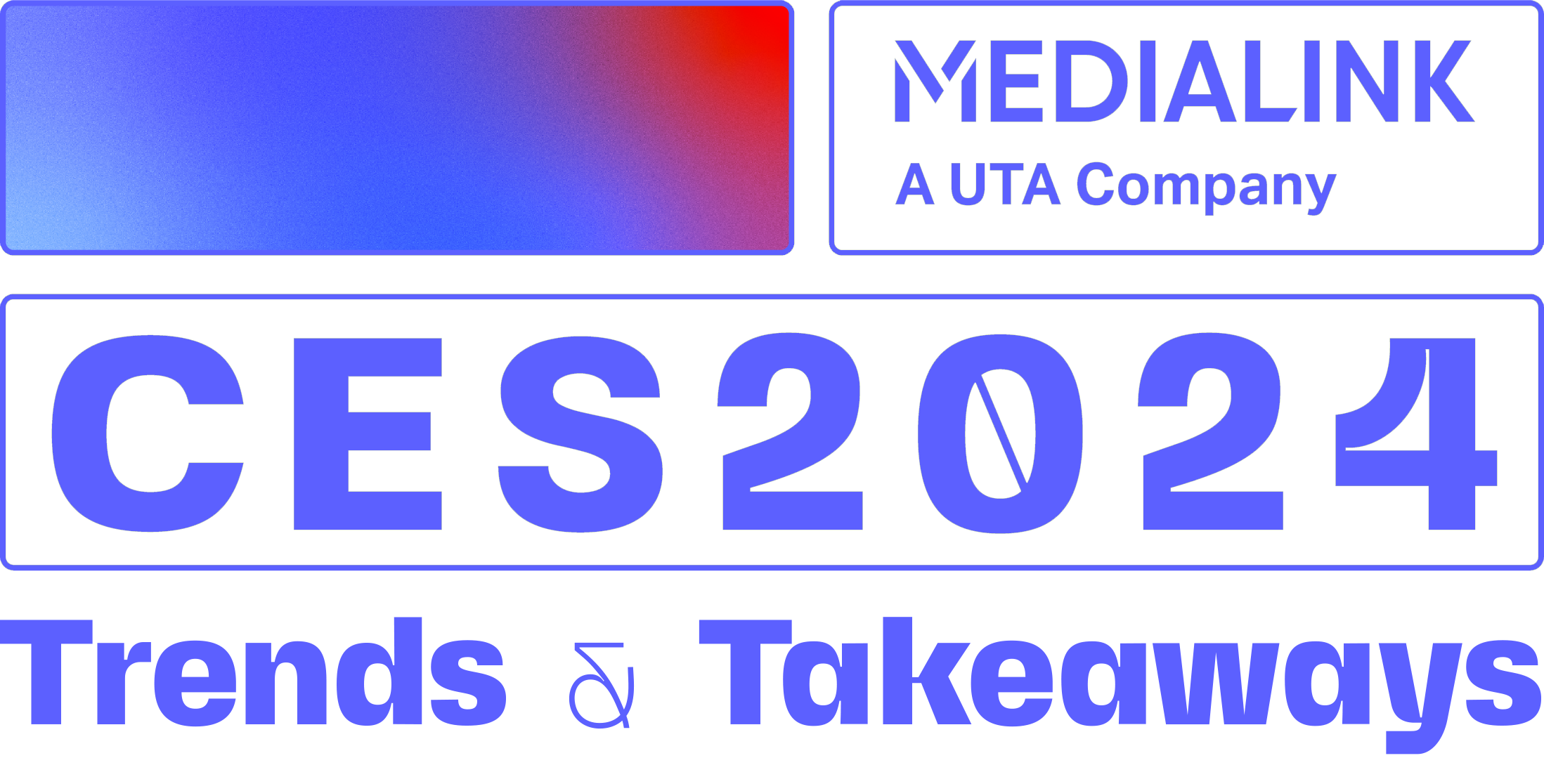


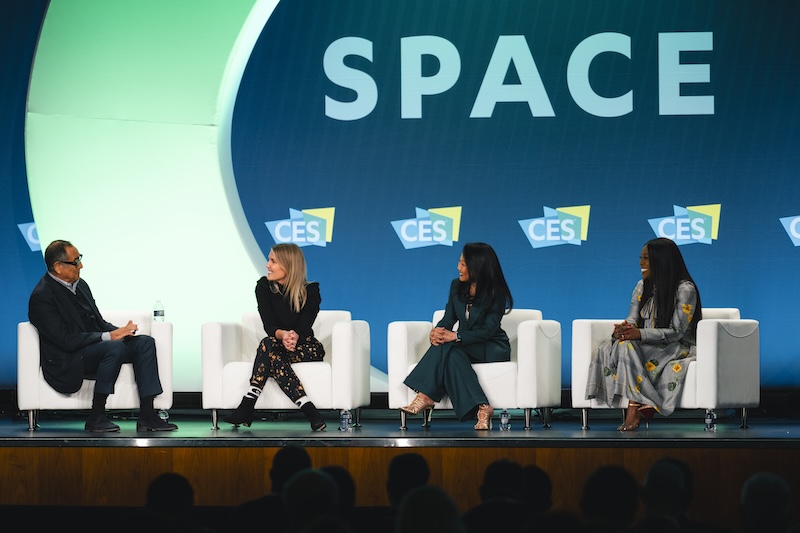 For the first time in a while, it felt like a normal CES. After making a post-pandemic comeback last year, this year’s event operated at full force – which should be a promising sign for the year to come. Of course, for a show that blends self-driving cars with robots and marketing cloud activations – normal is a relative term – and it certainly doesn’t imply “static.” As always, CES evolves and expands to represent the current state of the advertising, media, and marketing universe. As the number of players in the advertising space grew, so did the C Space itself – growing so large it expanded into the Cosmopolitan. Buyers and sellers came in droves – not just to ink deals and be inspired by technology, but to dig deep into business strategies and set the agenda for the next 12 months. Following are some of the highlights from CES 2024 that made waves for marketers – from MediaLink’s “Marketing Reinvented” stage to the halls of the Aria across the C Space:
For the first time in a while, it felt like a normal CES. After making a post-pandemic comeback last year, this year’s event operated at full force – which should be a promising sign for the year to come. Of course, for a show that blends self-driving cars with robots and marketing cloud activations – normal is a relative term – and it certainly doesn’t imply “static.” As always, CES evolves and expands to represent the current state of the advertising, media, and marketing universe. As the number of players in the advertising space grew, so did the C Space itself – growing so large it expanded into the Cosmopolitan. Buyers and sellers came in droves – not just to ink deals and be inspired by technology, but to dig deep into business strategies and set the agenda for the next 12 months. Following are some of the highlights from CES 2024 that made waves for marketers – from MediaLink’s “Marketing Reinvented” stage to the halls of the Aria across the C Space:
The Ad Business Is Having a Renaissance – With Many New Players
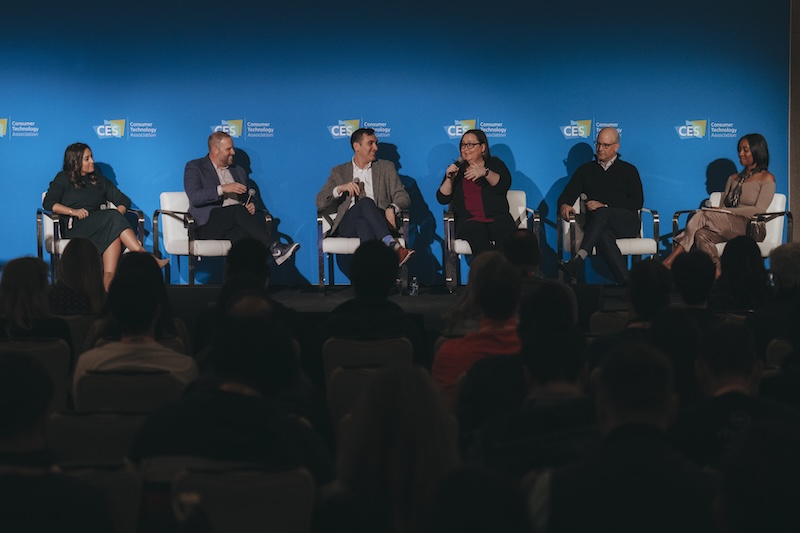 After a year of what felt like constant uncertainty, the economy appears to be on solid ground, which was reflected in the armies of ad executives roaming the halls of the Aria, as well as the sheer size of “lollipop row” – where a slew of staffers (some dressed as Elvis or even Prince) held circular signs on sticks directing executives to suites for high-powered meetings. The makeup of CES this year reflected the reality that a wide range of non-traditional advertising companies are now knee-deep in the advertising business. That, of course, included ad-supported streaming services like Netflix, Disney, and Amazon Prime Video, which are trying to figure out the best way to weave innovative advertising into the binge era. “[When it comes to streaming], everything in the industry should be anchored in what is the best experience for the consumer,” said Luke Kigel, VP, Advanced Marketing Capabilities, Kimberly-Clark, during a “Marketing Reinvented” session aptly titled “Streaming Wars: The Current & Future State of the Industry.” This year also featured a noticeable presence from relative advertising newbies ranging from Uber to CVS and Snowflake.
After a year of what felt like constant uncertainty, the economy appears to be on solid ground, which was reflected in the armies of ad executives roaming the halls of the Aria, as well as the sheer size of “lollipop row” – where a slew of staffers (some dressed as Elvis or even Prince) held circular signs on sticks directing executives to suites for high-powered meetings. The makeup of CES this year reflected the reality that a wide range of non-traditional advertising companies are now knee-deep in the advertising business. That, of course, included ad-supported streaming services like Netflix, Disney, and Amazon Prime Video, which are trying to figure out the best way to weave innovative advertising into the binge era. “[When it comes to streaming], everything in the industry should be anchored in what is the best experience for the consumer,” said Luke Kigel, VP, Advanced Marketing Capabilities, Kimberly-Clark, during a “Marketing Reinvented” session aptly titled “Streaming Wars: The Current & Future State of the Industry.” This year also featured a noticeable presence from relative advertising newbies ranging from Uber to CVS and Snowflake.
Bottom line: The good news is that most experts predict solid ad spending growth in 2024. The bad news is that competition is set to be fiercer than ever, given the growing number of players. The winners will likely be the companies that can master ad experience, targeting, ideally both, and that can get their offerings into the hands of brands early in the year. For that reason, many of these companies treated CES as an upfronts precursor.
Shoppable Everything
 In the lower floors of the Aria, TikTok streamed several live shopping events. Instacart featured a makeshift mini supermarket, while Amazon showed off an entire space worth of shoppable advertising case studies. And the retail media networks were out in full force. The growth in ad spending on “commerce media” has been staggering and happens to coincide with an industry-wide pullback on third-party data. Given that brands are looking for partners with deep pools of first-party data, as well as a proven ability to drive and track transactions, the timing is excellent. In fact, many of these retailers are looking to broaden their businesses beyond their owned and operated properties. "The year is all about retail-powered media and activating it in the broader market,” said Chris Rogers, Chief Business Officer, Instacart. In some cases, that may mean simply moving retail ads to the open web. But other retailers, such as Walmart, are looking to dial up in-store advertising. “We need to think of all facets that go into commerce – media, content, tech and in-store experience – from a broader perspective,” said Amie Owen, US Head of Commerce, UM. Additionally, executives like Albertsons Media Collective SVP, Retail Media Kristi Argyilan emphasized the importance of standardization as retail media networks reach a new stage of maturity and increasingly collaborate with the rest of the industry.
In the lower floors of the Aria, TikTok streamed several live shopping events. Instacart featured a makeshift mini supermarket, while Amazon showed off an entire space worth of shoppable advertising case studies. And the retail media networks were out in full force. The growth in ad spending on “commerce media” has been staggering and happens to coincide with an industry-wide pullback on third-party data. Given that brands are looking for partners with deep pools of first-party data, as well as a proven ability to drive and track transactions, the timing is excellent. In fact, many of these retailers are looking to broaden their businesses beyond their owned and operated properties. "The year is all about retail-powered media and activating it in the broader market,” said Chris Rogers, Chief Business Officer, Instacart. In some cases, that may mean simply moving retail ads to the open web. But other retailers, such as Walmart, are looking to dial up in-store advertising. “We need to think of all facets that go into commerce – media, content, tech and in-store experience – from a broader perspective,” said Amie Owen, US Head of Commerce, UM. Additionally, executives like Albertsons Media Collective SVP, Retail Media Kristi Argyilan emphasized the importance of standardization as retail media networks reach a new stage of maturity and increasingly collaborate with the rest of the industry.
Bottom line: Retail media shows no signs of slowing down – in fact, shoppable ad units continued to bleed into other media. However, it’s getting awfully crowded for brands, known for seeking out simplicity and standards in their media execution. We expect more collaborations to emerge in the year to come, following in the footsteps of those like Albertsons Media Collective’s deal with Criteo and Instacart’s pact with Google – both of which were unveiled at CES.
AI Everywhere
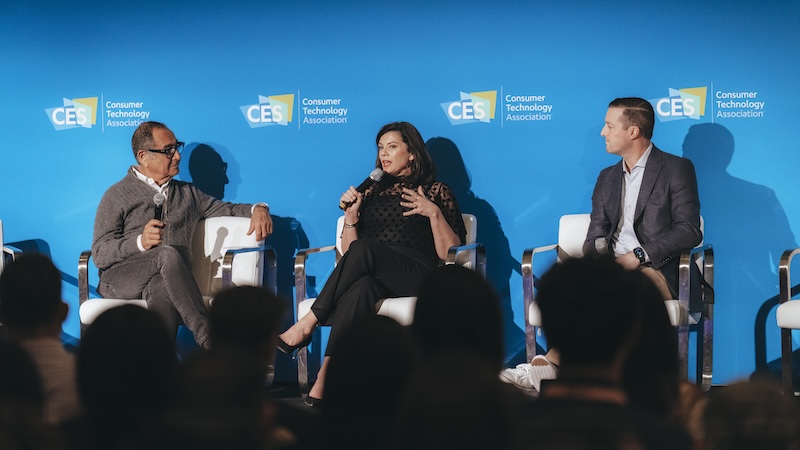 At last year’s CES, the world was still processing the rollout of ChatGPT – a time that felt like a different era. “Looking back just nine months ago, it feels like dial-up,” said Kristen O’Hara, VP, Agency, Platforms & Client Solutions at Google. Indeed, artificial intelligence dominated the conversation this year on a level that few other tech trends have approached in such a short period of time. That’s because the consensus is that AI will impact – well – everything. As Diana Haussling, SVP, General Manager, Consumer Experience & Growth, Colgate-Palmolive put it, “How we work and live will be dictated by AI.” Michael Kassan, CEO of MediaLink, told a story about how an industry leader once spoke about 5G as being the technology of yes, as in “yes, it will impact just about everything.” AI promises the same, effectively, only it will be ratcheted up tenfold. Whether it's media, sports, marketing, or Hollywood, “every one of those sectors is going to feel a massive impact from AI,” said Kassan. One aspect of work that has long produced anxiety – getting creative ideas off the ground – has yielded a lot of excitement around the vast possibilities. “The fear of the blank page is over,” said Eric Hall, CMO, Digital Experience Business at Adobe. That exuberance extends to media planning and optimization, as well as the more flashy aspects of AI. During the C Space Keynote with Kassan and CNBC Senior Media and Tech Correspondent Julia Boorstin, Snap Co-Founder and CEO Evan Spiegel noted that Snap has already seen great success with its products aimed at helping users send AI generated messages and visuals. In a session I moderated on immersive experiences, the technology also took center stage. Nickole Tara, Chief Growth Officer at Cirque du Soleil, explained how “AI will deepen the need for in-person experiences.” And Meta Chief Operating Officer, Reality Labs Dan Reed showed us first-hand, demonstrating the company’s new Ray-Ban Meta Smart Glasses powered by Meta AI. Getting the pipes in order will be critical. As Vinny Rinaldi, Senior Director of Media & Analytics at The Hershey Company emphasized, “Proper data architecture is going to be critical to unlocking the power of AI for all marketers.”
At last year’s CES, the world was still processing the rollout of ChatGPT – a time that felt like a different era. “Looking back just nine months ago, it feels like dial-up,” said Kristen O’Hara, VP, Agency, Platforms & Client Solutions at Google. Indeed, artificial intelligence dominated the conversation this year on a level that few other tech trends have approached in such a short period of time. That’s because the consensus is that AI will impact – well – everything. As Diana Haussling, SVP, General Manager, Consumer Experience & Growth, Colgate-Palmolive put it, “How we work and live will be dictated by AI.” Michael Kassan, CEO of MediaLink, told a story about how an industry leader once spoke about 5G as being the technology of yes, as in “yes, it will impact just about everything.” AI promises the same, effectively, only it will be ratcheted up tenfold. Whether it's media, sports, marketing, or Hollywood, “every one of those sectors is going to feel a massive impact from AI,” said Kassan. One aspect of work that has long produced anxiety – getting creative ideas off the ground – has yielded a lot of excitement around the vast possibilities. “The fear of the blank page is over,” said Eric Hall, CMO, Digital Experience Business at Adobe. That exuberance extends to media planning and optimization, as well as the more flashy aspects of AI. During the C Space Keynote with Kassan and CNBC Senior Media and Tech Correspondent Julia Boorstin, Snap Co-Founder and CEO Evan Spiegel noted that Snap has already seen great success with its products aimed at helping users send AI generated messages and visuals. In a session I moderated on immersive experiences, the technology also took center stage. Nickole Tara, Chief Growth Officer at Cirque du Soleil, explained how “AI will deepen the need for in-person experiences.” And Meta Chief Operating Officer, Reality Labs Dan Reed showed us first-hand, demonstrating the company’s new Ray-Ban Meta Smart Glasses powered by Meta AI. Getting the pipes in order will be critical. As Vinny Rinaldi, Senior Director of Media & Analytics at The Hershey Company emphasized, “Proper data architecture is going to be critical to unlocking the power of AI for all marketers.”
Bottom line: It won’t be easy for brands to sniff out what’s hype and what's not, considering that nearly every company in the industry is touting its AI bona fides – but as IAB CEO David Cohen put it, “AI is not a fad.” It will be crucial for marketers to get out in front of this technology, both by following consumer behavior while also getting educated on how AI is reshaping media buying, creativity, and even how organizations are run (according to UTA Partner & Chief People Officer Jean-Rene Zetrenne, “AI is a tool, it’s a technology and it’s a co-worker.”) Setting up a framework for readiness is step number one.
AI for Avenging
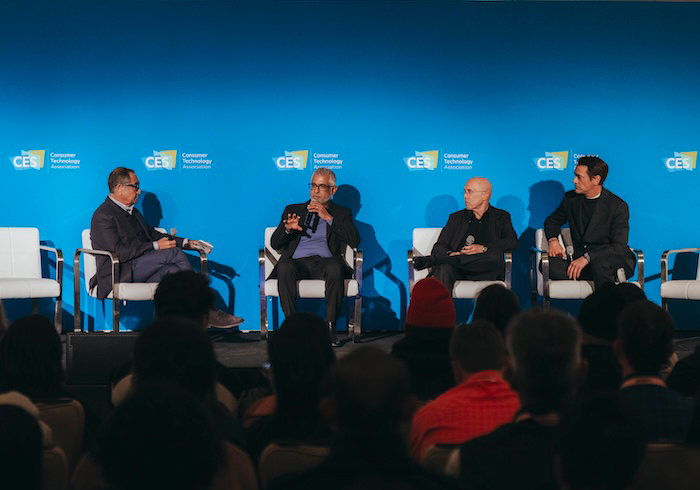 A staggering $10.3 billion was lost to online crime last year, according to the FBI – and that number is up a whopping 50% year over year. Yet most Americans are barely doing enough to protect themselves – if they are even aware of the potential threats posed. “What’s happened over the last decade is that it’s gotten very mainstream,” said Hari Ravichandran, Founder and CEO at Aura, a cybersecurity firm, in a special “Marketing Reinvented” session on the subject. Ravichandran noted that such financial crime has increased both in frequency and sophistication, and most existing protections aren’t keeping up. Enter media legend Jeffrey Katzenberg, and actor Robert Downey Jr., who have both taken on the cause of raising awareness and action regarding cyber-crime. “We spend millions protecting physical goods,” said Katzenberg, Founding Partner of WndrCo. “But our lives are actually more on these devices.” That’s something that we all need to take more seriously – before it’s too late, he warned. For Downey Jr., the mission is close to home, as he relayed a story of a close family member recently getting hacked – an experience that left her rattled. “You can barely keep up with [this], it’s so insidious. And the conversations are so personal and passionate. So, if we can use this AI revolution for good, that is the blank space we want to fill.”
A staggering $10.3 billion was lost to online crime last year, according to the FBI – and that number is up a whopping 50% year over year. Yet most Americans are barely doing enough to protect themselves – if they are even aware of the potential threats posed. “What’s happened over the last decade is that it’s gotten very mainstream,” said Hari Ravichandran, Founder and CEO at Aura, a cybersecurity firm, in a special “Marketing Reinvented” session on the subject. Ravichandran noted that such financial crime has increased both in frequency and sophistication, and most existing protections aren’t keeping up. Enter media legend Jeffrey Katzenberg, and actor Robert Downey Jr., who have both taken on the cause of raising awareness and action regarding cyber-crime. “We spend millions protecting physical goods,” said Katzenberg, Founding Partner of WndrCo. “But our lives are actually more on these devices.” That’s something that we all need to take more seriously – before it’s too late, he warned. For Downey Jr., the mission is close to home, as he relayed a story of a close family member recently getting hacked – an experience that left her rattled. “You can barely keep up with [this], it’s so insidious. And the conversations are so personal and passionate. So, if we can use this AI revolution for good, that is the blank space we want to fill.”
Bottom line: Marketers should play a bigger role in elevating the issue of digital financial crime. There is a major opportunity for solutions providers like Aura to not only address the issue, but change how people think about going online.
Creator Endeavors
 Besides the increased appearance of streamers and retailers, CES this year was crashed by more and more digital creators. As marketers continue to ratchet up their interest in the creator economy, as part of their efforts to reach Gen Z and even younger consumers, many creator-centric firms used CES to prove they belong alongside the biggest companies in media. Of course, simply buying creator ads is rarely the right strategy. “Creators are stewards and masters of their communities,” said Adam Bauer, SVP Partnerships at FaZe Clan, in a conversation with UTA Head of Gaming and Esports Damon Lau and other leaders in the space. “Treat them like your creative partners.” That’s easier said than done for some marketers, as it requires relinquishing control. “One of the big things that we try to do is be authentic as much as we can to the creator and make sure it’s the right fit for the brand,” said Vince Lim, Chief Creative Officer at Barbarian.
Besides the increased appearance of streamers and retailers, CES this year was crashed by more and more digital creators. As marketers continue to ratchet up their interest in the creator economy, as part of their efforts to reach Gen Z and even younger consumers, many creator-centric firms used CES to prove they belong alongside the biggest companies in media. Of course, simply buying creator ads is rarely the right strategy. “Creators are stewards and masters of their communities,” said Adam Bauer, SVP Partnerships at FaZe Clan, in a conversation with UTA Head of Gaming and Esports Damon Lau and other leaders in the space. “Treat them like your creative partners.” That’s easier said than done for some marketers, as it requires relinquishing control. “One of the big things that we try to do is be authentic as much as we can to the creator and make sure it’s the right fit for the brand,” said Vince Lim, Chief Creative Officer at Barbarian.
Bottom line: Clearly, the growing class of professional or semi-professional creators and the like are attracting massive audiences – and, in many cases, are trusted more than legacy media by younger consumers. Brands have a huge opportunity to participate and even help steer the creative process. As Han Wen, Chief Digital & Marketing officer at L’Oréal USA, put it, “Every single act of our daily lives can become a moment of culture creation.”
Get Paid Twice
As much as we’re seeing formerly ad-free services embrace ad-tiers, platforms like Snap are pushing into subscription products. Spiegel noted that Snapchat+ now boasts 7 million subscribers – an eye-opening figure for a free platform that skews toward teens. Users have taken to the premium service to customize their Snap experience and use new AI-powered communications tools. “In many ways, it gives us an excuse to build new features for our power users,” said Spiegel. “I hope that we can just continue to deliver innovative features people love.” Much like newspapers, magazines, and cable TV before them, media and platforms are learning once again “that loyalty that gets created with a subscription is a very valuable asset,” said Kassan, and “the dual income stream…we’re going to see that is the way we go forward.”
Bottom line: For some media companies, relying on advertising won’t be enough to make their economics work. Look for more experimentation with “special” exclusive products, tools, and offerings – both as a way to expand revenue opportunities and as a way to bring in more direct customer data.
Brand Safety Is Back

Bottom line: This issue looms to be a major challenge for brands for the foreseeable future. The entire industry will need to collaborate, and marketers in particular should lean on their agency partners for guidance. At the same time, media outlets and ad tech companies will need to move at a faster pace to handle these issues as they arrive and prioritize transparency – much as they did when they swiftly re-earned the trust of brands in 2020, brand safety’s original spotlight moment.
No Longer Accepting Cookies
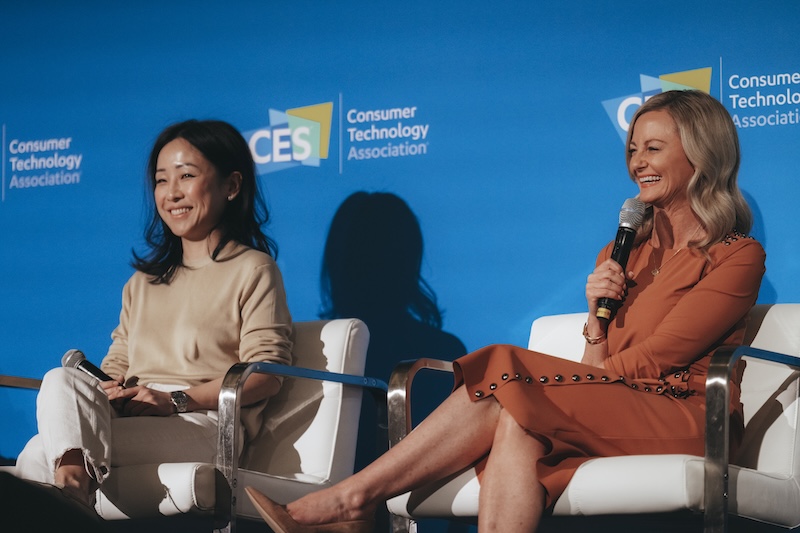 Marketers have spent the past several years racing to prepare for a non-cookie based world, and at long last it has finally arrived, as Google began its year-long deprecation of the technology on January 4. Naturally, how the industry is adjusting was a hot topic at CES. Many marketers like McDonald’s have spent the past few years looking to amass more data from customers. “The way in which we actually develop a loyalty program to really be able to deliver the right experience to customers – [that demonstrates] the increasing importance of first-party data,” said Allegra Krishnan, Vice President and Chief Loyalty & Engagement Officer at McDonald's on the C Space Keynote stage with Lynn Teo, Chief Marketing Officer, Northwestern Mutual and Dara Treseder, Chief Marketing Officer, Autodesk. The MyMcDonald's Rewards program barely existed a few years ago, explained Krishnan, and now it’s a huge priority. In today’s privacy-focused environment, “How do we actually bring loyalty to life, in a meaningful and engaging way?” Delta Air Lines CMO Alicia Tillman underscored the importance of bringing engagement to life, saying that modern consumers “are not only expecting perfection from a product perspective, but they’re expecting to have an experience with that product.” Of course, consumers are increasingly being cautious about sharing, which adds to the challenge for brands – and may require many to shift their way of approaching customer interactions online. “You can’t lie yourself away around trust,” said Teo. “The bottom line of loyalty is trust and reliability. Brands that think of themselves as being of service will tend to win.” “There is so much uncertainty in the world,” added Treseder. “Customers are asking, ‘who is that partner who is going to help me navigate that uncertainty?’”
Marketers have spent the past several years racing to prepare for a non-cookie based world, and at long last it has finally arrived, as Google began its year-long deprecation of the technology on January 4. Naturally, how the industry is adjusting was a hot topic at CES. Many marketers like McDonald’s have spent the past few years looking to amass more data from customers. “The way in which we actually develop a loyalty program to really be able to deliver the right experience to customers – [that demonstrates] the increasing importance of first-party data,” said Allegra Krishnan, Vice President and Chief Loyalty & Engagement Officer at McDonald's on the C Space Keynote stage with Lynn Teo, Chief Marketing Officer, Northwestern Mutual and Dara Treseder, Chief Marketing Officer, Autodesk. The MyMcDonald's Rewards program barely existed a few years ago, explained Krishnan, and now it’s a huge priority. In today’s privacy-focused environment, “How do we actually bring loyalty to life, in a meaningful and engaging way?” Delta Air Lines CMO Alicia Tillman underscored the importance of bringing engagement to life, saying that modern consumers “are not only expecting perfection from a product perspective, but they’re expecting to have an experience with that product.” Of course, consumers are increasingly being cautious about sharing, which adds to the challenge for brands – and may require many to shift their way of approaching customer interactions online. “You can’t lie yourself away around trust,” said Teo. “The bottom line of loyalty is trust and reliability. Brands that think of themselves as being of service will tend to win.” “There is so much uncertainty in the world,” added Treseder. “Customers are asking, ‘who is that partner who is going to help me navigate that uncertainty?’”
Bottom line: Marketers that have been out in front of this much-extended deadline should be far better set up to thrive this year. But the loss of cookies brings with it lots of unknowns. Clearly, consumer trust is highly valuable and highly fragile. Marketers will need to test as many cookie alternatives as possible, even as conditions on the ground keep changing. Whichever path they choose – they’ll need to think consumer-first. If the start of this year is telling, the excitement generated by CES bodes well for the rest of the year for the ad industry. Not only is growth on the table, but a wider array of contenders are likely to benefit. That is, as long as they are able to deliver strong data, software, and audience to brands. At the same time, it’s so far from business as usual in the ad world. The innovation that promises to emerge this year from AI and other technologies is bound to transform an untold number of practices in this business. The marketers who are able to stay on the cusp of this change and ensure their customers are beneficiaries are the ones most likely to succeed.

Samantha Goldfeder, Senior Vice President, MediaLink
“Considerate technology” dominates
While AI dominated the week at CES, there was a noticeable evolution from efficiency and automation to human-focused and purpose-driven applications. From conversations in the C Space to keynotes to the show floor, brands were leaning into AI-powered technology that is not only innovative but also applicable and accessible for all communities.
Mastercard debuted their new AI tool to create mentorship at scale for small businesses. EssilorLuxottica exhibited a prototype of their Nuance Audio smart glasses that integrate advanced hearing technology. L'Oréal showcased a new tool called Hapta that stabilizes make-up applications for people with hand-related disabilities. And AARP curated an entire section of AgeTech in support of making aging easier, from digital healthcare records to accessibility to preserving digital legacies.
The intersection of innovation and humanity, dubbed “considerate technology” in conversations last week, will be a key as brands build stronger and longer-lasting relationships with their consumers.
Sosti Ropaitis, Executive Vice President, MediaLink
The shift from curation to generation
As discussed by Brian Cooley and David Shing during OMG’s Transformation Experience panel, advancements in Gen AI are allowing quick generation of video and image assets with limited knowledge of film production. In most cases, the input is text based and the output is high quality content. This explosion of premium video content will breed a new era of social influence that marketers need to nurture, as it will become the backbone of their digital strategy.
Relentless focus on Hyper-Personalization
AI is transforming connected devices by allowing instant computation of terabytes of data to produce individually tailored recommendations to each user. From cameras that scan your food and give nutritional values and recommendations to L’Oréal’s Beauty Genius that suggests beauty routines and products, personalization is the focus of most tech companies exhibiting at CES. Customer journeys will become more complex as IOT moves from information to recommendations. Marketers are now called to focus on programs that position their brand as the catalyst for providing added value to their audience.
Everything is connected and linked…and so is private data.
Announcements from the show demonstrated that as more connected devices are coming online, open protocols/standards like Matter are now in demand for greater interoperability and consumer ease of use. Evolved privacy regulations that protect the user will continue to be a major focus in 2024 as more and more cases of updated terms and conditions from big companies have users handing over their device content to the cloud for public use on-demand.
David Muldoon, Vice President, MediaLink
Innovation can drive success and so much more
At CES 2024, I started my week at the L’Oréal Keynote and reflected on their pivot from a beauty brand (the first to present a keynote at CES) to a brand at the forefront of the tech industry. Whilst they had some impressive product launches, it was the purpose of this pivot that intrigued me.
The hope is that ground-breaking products drive revenue and market share; however, innovation and success should also be measured on much more than that. The impact that it has on recruitment, investor confidence, employee satisfaction, and PR shows that brands must innovate to drive meaningful short- and long-term value and genuine excitement.
This starts with a clear North Star, a lofty ambition that everyone in your company can get behind, can drive towards and can understand how they contribute. If you can do this and are hyper-focused on the needs of the consumer, using innovation to solve an unmet consumer need, the Consumer Technology Association has been showing us for 100 years the success that this can have.
Heather Dumford, Executive Vice President, MediaLink
Immersion is paramount
While the word Metaverse has gone from craze to triggering eye rolls, the tech world is shifting to talk about spatial computing. This is a term that has much broader implications covering experiences that merge physical and digital worlds including the Metaverse but also device experiences.
Several related key device launches took center stage at CES 2024. Whether it was Sony launching their spatial content creation system, Apple announcing the February release date of the VisionPro, or Acer debuting their Aspire 3D 15, the opportunity to engage in our physical world, virtualized and overlayed with virtual information, is richer than ever. With the help of AI, spatial computing experiences are now possible to a much wider audience, and many experiences do not require a headset, like Acer’s laptop, or even a special device like those developed by MeetKai that are accessible via browsers.
While this opportunity to break free from translating creativity in a 2D world is exciting, the ability to execute is challenging marketers to consider a more holistic way for the brand and products to exist, meaningfully include the consumer in the story being told, and requires a more continuous process for content creation optimizations. While more progressive brands like L’Oréal with their launch of Beauty Genius and BYD with their digital twin showroom and test drive experiences are already fully engaging in this space, the race is on for more brands to think beyond their transactional digital websites to truly integrate the physical and digital worlds for immersive experiences.
Eugene Wu, Head of Talent Brand Partnerships, Gaming & Esports, UTA
The power of creators
What wowed me the most about CES this week was the confirmation from brands that creators are the new channel of preferred media placement. Many brands acknowledged the need to pivot traditional media strategies heading into 2024 due to new privacy laws preventing the use of cookies to track and retarget consumer behavior. Brands are now turning to the creator economy and have acknowledged that it’s the creators themselves that hold the keys to the relationship with their end consumers, NOT traditional publications. The Omnicom and Amazon partnership was the most interesting partnership announcement of the week for me, as it will allow marketers to truly see how creators can not only give unforced access to communities and consumers but also allow brands to track and measure content (both upper and lower funnel) when we embark in a world without cookies.
One learning I’d bestow on marketers post-CES is that brands are realizing quickly that the traditional creative and advertising strategies they push to consumers are often “hostage ads” – forced content that is disruptive. The solution is to be integrated and drive value to the content consumers are watching. Be part of and drive value to content; do NOT become the disruptive mid-roll. You can have the best creative ad in the world, but if you force it onto consumers, you are still holding your viewers “hostage” to what they actually want to do, and that is no way to start or continue any form of a healthy and long-term relationship. Partner with creators who have access to the communities you want to communicate to and invest and drive value to those communities.
Chloe Popescu, Agent, UTA
Tech beyond the consumer
What CES made clear this year is that tech has the potential to make everything feel more human and more accessible – including AI. The UN declared tech to be a basic human right, and what we’re seeing is that the most innovative companies are considering the pillar of tech for good in addition to user experience, customer needs, and a competitive bottom line.
This application came through across a number of exhibitions and keynotes at the show – whether it was Panasonic’s booth that showed products and technology under the three categories of “Sustainable Energy,” “Circular Economy,” and “Resource Optimization,” or Best Buy’s focus on assistant devices and health tech tracking.
Marketers that consider and integrate more global, social, and environmental use cases for technology will fare well in the eyes of consumers.
Jonah Minton, Senior Vice President, MediaLink
The future is here
CES 2024 felt distinct from previous years. It felt as if the future was unfolding in real-time. From Sphere demonstrating the future of immersive entertainment, to AI being integrated into every aspect of technology, hardware, software, and business – everything felt immediate and tangible. The showcased technologies were not speculative projects, but real products impacting our lives today. For marketers, the big takeaway is speed and immediacy of the technology revolution and the requirement to aggressively test and develop implementation strategies for disruptive technologies and products that are revolutionizing our entertainment, media, marketing and advertising industries.